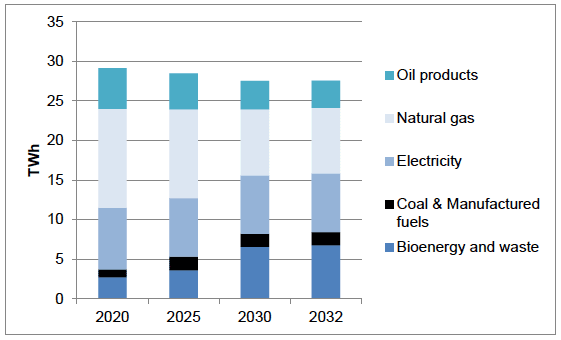Climate Change Plan: third report on proposals and policies 2018-2032 – technical annex
This annex provides an overview of the analysis underpinning the Climate Change Plan
Industry
Sector Overview:
Industrial emissions are comprised of three components within Scottish TIMES: A refinery subsector, a hydrogen-manufacturing sector, and a further industrial module composed of six subsectors, which can consume oil products and hydrogen, as well as a range of other primary feedstock and fuels to produce products and meet their final energy demands.
The refining and hydrogen manufacture components are the upstream processing industries that convert primary fuels into secondary products. The industrial component comprises: Chemicals, Cement, Iron & Steel, Food & Drink, Paper & Pulp and other smaller industries.
Data Inputs:
Current final energy demands, estimated future growth rates and costs for each sector were inherited from UK TIMES and scaled down for Scotland, using Scottish data where possible. Figures for industrial base year production were derived from a variety of sources, such as publicly available company data, and analysis published by the UK Government (2015) [10] . All demands were then calibrated to the emissions for each specific industrial sector in the inventory.
Additional constraints since the Draft Plan:
We have constrained the use of biomethane and other biomass in industrial processes fitted with CCS, thereby eliminating the model's ability to produce negative emissions in the industrial sector. We have also delayed the adoption of CCS in all industrial processes until after 2030.
We have ensured that a minimum share of non-electric heat is supplied by biomass boilers, reflecting current activity.
Results:
The figure below presents the breakdown of fuel consumption for energy use by type. There is a shift away from fossil fuels such as natural gas and oil products and towards bioenergy, including waste.
This coincides with a fall in fuel consumption for energy use of over 5% over the period, which reflects the move towards more efficient technologies and processes, in the context of increasing overall demand growth.
Figure 15: Breakdown of Fuel Consumption for Energy Use by Type ( TWh), TIMES model results

The volumes of hydrogen produced throughout the Plan remain low, with negligible production in 2020, increasing to around 0.4 TWh in 2032. Until 2030, all hydrogen is made from Steam Methane Reforming. After 2030, there is a shift towards the manufacturing of hydrogen from Steam Methane Reforming with CCS. CCS has been constrained until after 2030 and, as a result, there are negligible levels of captured emissions by 2032.
Contact
There is a problem
Thanks for your feedback